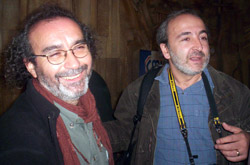“We have entrusted Istanbul to the Armenians and the Armenians have trusted us with Istanbul,” says Turk photographer Osjan Yurdalan while presenting his photo project for the “Merhabarev” Turkish-Armenian joint photo exhibition. The exhibition began a year ago with the initiative taken by the Caucasian Institute of Mass Media.
Five Armenian photographers went to Istanbul, while five Turkish photographers went to Yerevan. There are diplomatic relations between Armenia and Turkey and the closed borders isolate the two countries even more. That’s why culture serves as the first step towards starting a dialogue.
Armenian photographers Ruben Mangasaryan, German Avagyan, Nelly Shishmanyan, Anahit Hayrapetyan and Karen Mirzoyan were present during the opening of the exhibition. Osjan Yurdalan was the only Turk photographer there and was nervous by being in the center of attention. “I’m amazed at the behavior of Armenians. People in the city were okay with the fact that I’m Turk, I could talk Turkish whenever I wanted to on the streets and tell the people whom I was photographing that I’m Turk. I never say any negative reaction from them. People actually came up to me and wanted to talk. They were even inviting me to their homes to drink Turkish coffee.”
The Turk photographer said that this photo-exhibition is the main news spreading around in Turkey and all the presses feature this as the headline. According to Osjan Yurdalan, the main difference between Yerevan and Istanbul is that Istanbul is a city of art.
“There is a cultural event every day in Istanbul-concerts, exhibitions or film premieres. It’s like that in Istanbul.”
The photographs don’t remind the viewer of the past and are not aimed towards portraying the total image of neither of the cities. Better yet, they are photographs that were taken through the means of getting acquainted with the city and the citizens. Ruben Mangasaryan said that they had decided to refrain from color photographs in order to keep the documental part and make all the photographs black and white. You can see many faces of people walking, playing instruments, swimming in pools, shopping in the photographs.
“We couldn’t say ‘close your eyes and don’t look at this’ to one another. I’m sure that Turk and Armenian photographers have things that they wouldn’t want the world to see,” said Nelly Shishmanyan.
In reality, the photographs prove that the two cities are more alike than different. Perhaps that’s how it turned out; after all, people are the same wherever they are. However it was hard to decipher whether the children in the photographs were Armenian or Turk.
Musician Arto Tunchboyadjyan, who considers Yerevan and Istanbul his home cities, was also present at the exhibition.
“We like to keep saying that the world is everyone’s, it’s ours, but we’re not true to ourselves. The thing that bothers us is the lie; the lie that doesn’t allow us to live in peace and harmony.”
The exhibition whose title is the assimilation of the Turkish and Armenian equivalents of “hello”, will also be shown in Gyumri and Istanbul.
“We Armenian photographers had to wait these many years to go to Istanbul and freely take photos of the city. But how many years have to pass for me to be able to go to Azerbaijan and take photos of my home village of Kerkej?” said German Avagyan.

